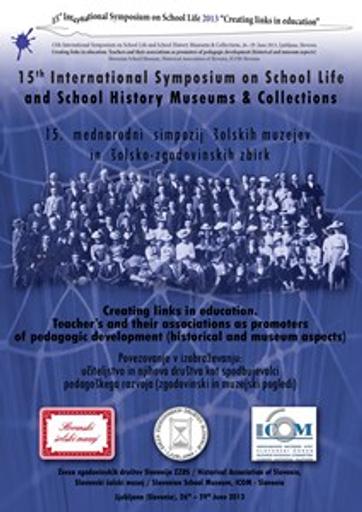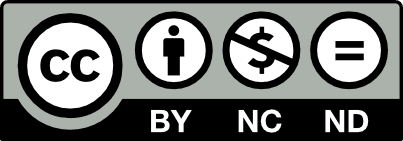/
Dogodki
/
Konference
Wall charts and state of the art. Teachers, object lessons and new pedagogy in Denmark around 1900 - and today

Avtor(ji):Anne Katrine Gjerløff
Soavtor(ji):Tijs van Ruiten (mod.)
Leto:2013
Založnik(i):Slovenski šolski muzej, Ljubljana, Zveza zgodovinskih društev Slovenije, Ljubljana, ICOM Slovenija, Celje, Inštitut za novejšo zgodovino, Ljubljana
Vir(i):Session 5 B: Museums III
Jezik(i):angleščina
Vrst(e) gradiva:video
Avtorske pravice:

To delo avtorja Anne Katrine Gjerløff je ponujeno pod Creative Commons Priznanje avtorstva-Nekomercialno-Brez predelav 4.0 Mednarodna
Datoteke (1)
Opis
In 1887 the Danish School Museum opened in modest quarters in the attic of a municipal school near
Copenhagen. In the next decades the collection expanded and received financial support from the state and the
Danish teachers association (founded 1874). Both at the museum and at the annual conferences teachers could
get inspiration for state of the art pedagogy through the collections of new and exciting teaching materials.
The Danish School Museum had a major collection of more than 12.000 wall charts, collected from all
over Europe. The wall charts was a well-known and widely used tool for the new teaching method “object
lessons” that became mandatory in the Danish primary school system in 1900.
Even though “object lessons” were an old pedagogical idea dating back to Comenius’ principle of
autopsy (“to see for oneself”), the method was closely connected to and promoted by a group of young,
internationally oriented Danish teachers. The New Pedagogues – as they called themselves – used object lessons
as a tool for educating the logic, the senses and the language of the child, as opposed to more traditional
pedagogy based on memorizing facts.
The paper will outline the history of the Danish School Museum and the connection between the new
pedagogy and the collections of teaching materials in Denmark around 1900, with special regards to the wall
charts. In addition the paper will present the history of the collection of the wall charts through the 20. Century
until today, where the collection survives at the Danish Library of Education. During 2013 the whole collection
will be digitalized and catalogued for open access by the public, and the paper will discuss the perspectives for
exhibitions and research on the history of education and pedagogy using this and similar collections.
Metapodatki (12)
- identifikatorhttps://hdl.handle.net/11686/37679
- naslov
- Wall charts and state of the art. Teachers, object lessons and new pedagogy in Denmark around 1900 - and today
- Anskuelsestavler og nypædagogik – Lærere, anskuelsesundervisning og nye pædagogiske strømninger i Danmark omkring 1900 – og i dag
- ustvarjalec
- Anne Katrine Gjerløff
- soavtor
- Tijs van Ruiten (mod.)
- predmet
- zgodovina
- šolstvo
- muzej
- history
- school system
- museum
- opis
- In 1887 the Danish School Museum opened in modest quarters in the attic of a municipal school near Copenhagen. In the next decades the collection expanded and received financial support from the state and the Danish teachers association (founded 1874). Both at the museum and at the annual conferences teachers could get inspiration for state of the art pedagogy through the collections of new and exciting teaching materials. The Danish School Museum had a major collection of more than 12.000 wall charts, collected from all over Europe. The wall charts was a well-known and widely used tool for the new teaching method “object lessons” that became mandatory in the Danish primary school system in 1900. Even though “object lessons” were an old pedagogical idea dating back to Comenius’ principle of autopsy (“to see for oneself”), the method was closely connected to and promoted by a group of young, internationally oriented Danish teachers. The New Pedagogues – as they called themselves – used object lessons as a tool for educating the logic, the senses and the language of the child, as opposed to more traditional pedagogy based on memorizing facts. The paper will outline the history of the Danish School Museum and the connection between the new pedagogy and the collections of teaching materials in Denmark around 1900, with special regards to the wall charts. In addition the paper will present the history of the collection of the wall charts through the 20. Century until today, where the collection survives at the Danish Library of Education. During 2013 the whole collection will be digitalized and catalogued for open access by the public, and the paper will discuss the perspectives for exhibitions and research on the history of education and pedagogy using this and similar collections.
- I 1887 åbnede Dansk Skolemuseum i beskedne omgivelser på loftet af Gladsaxe skole nær København. I de følgende årtier blev samlingerne udvidet, museet flyttede til bedre lokaler og fik økonomisk støtte fra staten og Danmarks Lærerforening (grundlagt 1874). På museet og ved de store lærerkonferencer kunne skolelærere få inspiration til nye pædagogiske metoder gennem udstillinger af nye og spændende undervisningsmidler. Dansk Skolemuseums samling rummede ved sin lukning, efter en omskiftelig tilværelse, i 2008 over 12.000 anskuelsestavler, indsamlet fra hele Europa gennem årtier. Anskuelsestavler var et vidt udbredt redskab til den nye undervisningsmetode ”anskuelsesundervisning” der blev obligatorisk i den danske grundskole med Det Sthyrske cirkulære i 1900. Selvom anskuelsesundervisning byggede på et gammel og velkendt pædagogiske princip, der kan føres tilbage til Comenius’ princip om autopsi (at lære ved selvsyn), var metoden omkring 1900 forbundet med og anbefalet af en gruppe af unge, internationalt orienterede lærere, der kaldte sig selv for Nypædagoger. Nypædagogerne brugte anskuelsesundervisning som en metode til at udvikle og opdrage barnets logik, sanser og sprog – som modsætning til den mere traditionelle pædagogik der ofte var baseret på udenadslære. Dette oplæg skal give et rids af Dansk Skolemuseums historie og af sammenhængen mellem nypædagogikken og udstillinger af undervisningsmaterialer i Danmark omkring 1900, med særlig vægt på anskuelsestavlerne. Desuden skal oplægget fremlægge historien om samlingen af anskuelsestavlerne op gennem det 20. århundrede og til i dag, hvor tavlerne findes på Danmarks Pædagogiske Bibliotek. I løbet af 2013 bliver hele samlingen digitaliseret og gjort offentlig tilgængelig på nettet, og oplægget vil også give bud på perspektiver for udstilling og forskning med udgangspunkt i denne og andre uddannelseshistoriske samlinger.
- založnik
- Slovenski šolski muzej
- Zveza zgodovinskih društev Slovenije
- ICOM Slovenija
- Inštitut za novejšo zgodovino
- datum
- 2013
- 27. 06. 2013
- tip
- video
- jezik
- Angleščina
- jeDelOd
- pravice
- licenca: ccByNcNd
